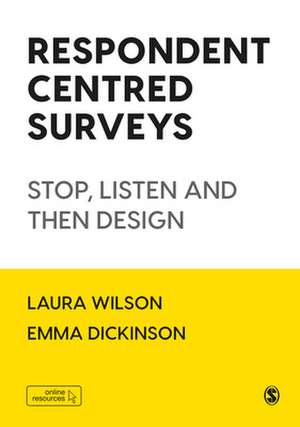Respondent Centred Surveys: Stop, Listen and then Design
Autor Laura Wilson, Emma Dickinsonen Limba Engleză Paperback – dec 2021
Too often, surveys are designed for the analyst, rather than the respondent. This book challenges the status quo by putting respondents’ needs at the heart of survey development. It encourages you to stop, listen, and then design to improve response rates and collect high quality data.
Drawing on their experience at the UK Office for National Statistics, the authors:
- Show you how to design better surveys by combining social research and user experience best practice.
- Equip you with the tools to design inclusive and accessible surveys.
- Enable you to overcome practical research problems, including managing participant recruitment, and working to any budget.
- Provide links to helpful web material and further reading as part of the book's online resources.
| Toate formatele și edițiile | Preț | Express |
|---|---|---|
| Paperback (1) | 479.17 lei 6-8 săpt. | |
| SAGE Publications – dec 2021 | 479.17 lei 6-8 săpt. | |
| Hardback (1) | 1281.79 lei 6-8 săpt. | |
| SAGE Publications – 5 dec 2021 | 1281.79 lei 6-8 săpt. |
Preț: 479.17 lei
Nou
91.69€ • 98.05$ • 76.45£
Carte tipărită la comandă
Livrare economică 18 aprilie-02 mai
Specificații
ISBN-10: 1529701260
Pagini: 248
Dimensiuni: 170 x 242 x 18 mm
Greutate: 0.74 kg
Ediția:1
Editura: SAGE Publications
Colecția Sage Publications Ltd
Locul publicării:London, United Kingdom
Recenzii
It makes a welcome addition to the survey design literature and provides valuable practical advice and guidance, not only for those working on large, complex surveys in national statistical institutes, but for anyone interested in improving surveys for those who give up their time to respond to them. I expect this book will be widely used by practitioners and researchers alike.
This book brings respondent-centred design front and center in survey design and administration, the philosophy being that the product (the survey instrument) should match the user (respondent), rather than the other way around. By bringing principles of user experience (UX) research into survey design, the authors turn the traditional process around, starting with respondents first, and providing concrete examples of the successes of this approach from the Office for National Statistics.
A book ahead of its time and a must-read for both survey and UX communities.
We are all facing declining response rates to our surveys, and our respondents increasingly expect that any worthwhile survey will conform to the best practices of the age of digital. This book introduces survey methodologists to ‘respondent-centred design’, firmly based on years of experience of improving the respondent experience of surveys at the UK Office of National Statistics. I particularly recommend Chapter 2, on principles, and the many detailed case studies that show how their approaches work.
Surveys aren’t the quick and easy insight gathering tools people imagine them to be. It takes a lot of work to deliver a high quality survey from start to finish. This book will help you do just that: it’s a practical guide to creating surveys in a respondent-centred and agile way, meeting the needs of respondents and data users alike, by creating something that is understandable and relevant. This will help you, as survey creators, to do the hard work to make things simple.
This is an important book and a must-have for anyone involved in designing or commissioning surveys. Packed with examples, it illustrates the value of adopting a respondent-centred design approach and how it can be applied.
The book makes a powerful case for the involvement of members of the target population in the development of the survey, building bridges between survey methodology and user design to illustrate the value and role of user insights in the survey design process.
In bringing together modern design-thinking and traditional survey methodologies Laura and Emma have struck gold and landed on an approach that has the potential to influence survey design far beyond the National Statistical Institutes.
My time at the Office for National Statistics as Head of Digital Transformation cursed me with an understanding of what good survey design required but without the language to share that knowledge. This book provides a blueprint for anybody who, like me, has a vested interest in improving survey design wherever you might encounter it on the internet.
Cuprins
Chapter 2: Respondent-centred design in practice
Chapter 3: Agile project management applied to surveys
Chapter 4: Research operations part one: Research design and management
Chapter 5: Research operations part two: Conducting and analysing your research
Chapter 6: Creating a respondent-centred survey engagement strategy
Chapter 7: Creating respondent-centred household composition and socio-demographic survey questions
Chapter 8: Creating respondent-centred labour market survey questions
Chapter 9: Conclusion
Notă biografică
Laura is a Principal Social Researcher and the Data Collection lead for the UK Government Data Quality Hub (DQHub). Although based at the Office for National Statistics (ONS), the remit of her role extends to improving the quality of all data across government.
Laura is an expert qualitative researcher with over a decade¿s industry experience in designing and developing official government surveys. Prior to working in DQHub, Laura led a Research and Design Team in ONS which was responsible for the transformation of its Social Surveys. There she pioneered and embedded a respondent centred approach to survey development which transformed the respondent user experience.
Laura has a passion for ensuring data are collected accurately at source, and for bringing respondent needs to forefront of survey design.
